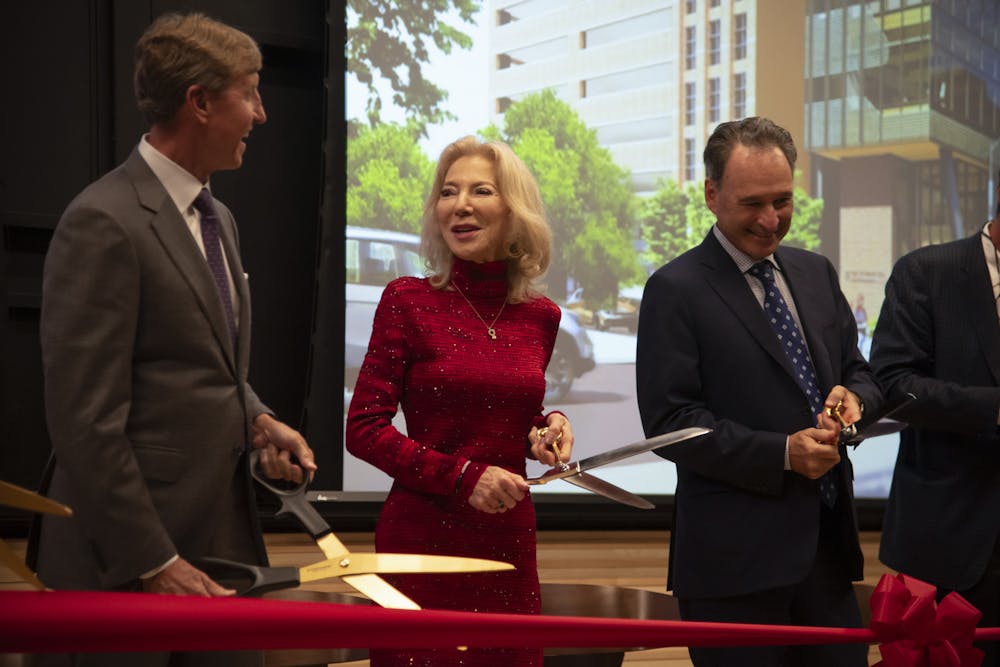
Penn held a dedication ceremony for Amy Gutmann Hall — the newest Penn Engineering building — on Friday, featuring several senior administrators including Interim Penn President Larry Jameson, former Penn President Amy Gutmann, and Engineering Dean Vijay Kumar.
Amy Gutmann Hall is a 116,000-square-foot, six-floor building is located on the northeast corner of 34th and Chestnut streets. It is set to officially open in January 2025 as a dedicated space for artificial intelligence and data science research.
“Today is a day of celebration,” Kumar said while opening the event. “It's the start of a new chapter in Penn’s leadership in AI and data science.”
The project first broke ground in October 2021. Lake Flato with KSS Architects — the same group responsible for Tangen Hall — designed the building with an emphasis on sustainability.
The building’s structure is made of 82 truckloads of timber, making it the first mass timber building in the city of Philadelphia. According to Kumar’s remarks, the use of timber reduces a building's embodied carbon footprint by an estimated 55 to 70% and cuts down construction time by 40%.
The building aims to make AI and data science tools and concepts more accessible and strengthening the Philadelphia tech ecosystem. It will also provide a home at Penn for centers focused on scientific discovery, computer vision, natural language processing, cybersecurity, medical diagnostics, drug discovery, and intelligence systems.
The building will also “lead to the development of safe, trustworthy, and explainable AI innovations for humanity,” Kumar said.
“I think you all know that there are essentially limitless applications of data science and artificial intelligence, and what we want is near universal access to these tools, and we're getting closer to that universal access,” Jameson said during the ceremony. “Where access and application come together, there's synergy and there's power. This is where the world needs Penn.”
The building was dedicated to Gutmann for her “indelible impact on the Penn community” and trailblazing career in higher education and politics.
Kumar called Gutmann’s 18-year tenure as Penn president — the longest ever — “an era of unprecedented growth and achievement across the university.”
“This building's purpose is forward looking, and it's forward looking in a collaborative sense, in bringing people who have different expertise, different visions of the future together and together to make a positive difference for the good of our society,” Gutmann said to attendees. “I'm humbled that this building bears my name, or at least the name of a person who has the same name as I do.”
The event was attended by a crowd for whom the building was “a labor of love,” Kumar said.
Board of Trustees Chair Ramanan Raghavendran, 1980 College graduate and trustee and naming donor Harlan Stone, and Penn Engineering Board of Advisors chair Rob Stavis were in attendance at the private ceremony.
Kumar went on to thank a number of administrators and donors who “made Amy Gutmann Hall a reality,” including Provost John Jackson Jr., former Interim Penn president and former Provost Wendell Pritchett, former Provost Beth Winkelstein, Senior Executive Vice President Craig Carnaroli, the architecture team, the Gilbane building company, Engineering chief of staff Chambrel Jones, and Philadelphia Councilmember Jamie Gauthier.
He also recognized Stone, who donated $25 million for the creation of the hall in November 2019.
“None of us would be here without Harlan’s transformational and foundational gift, the largest in our school's history,” Kumar said.
Stone highlighted the purpose of the building as a place for the “interdisciplinary search for knowledge." He referenced the recent announcement of the new Center for the Study of Media, Technology and Democracy, a collaboration of six of Penn’s schools that will be housed in Amy Gutmann Hall.
“Buildings say something about the culture of an institution,” Raghavendran said in his remarks. “I have to say, I'm a little envious of our current and future students and the opportunities they'll have: all I got was DRL.”
Gutmann, Jameson, Stone, Raghavendran, Kumar, and Stavis concluded the event by cutting a ceremonial red ribbon.
While wrapping up his remarks, Stone noted that the potential of tools like data science, machine learning, large language models and AI were “unimaginable only a short time ago.”
“Now we have a place, here at the intersection of 34th and Chestnut, where we can apply these tools to the pressing needs of our time,” he said. “I can say with some level of certainty that I believe Ben Franklin would be very proud.”
The Daily Pennsylvanian is an independent, student-run newspaper. Please consider making a donation to support the coverage that shapes the University. Your generosity ensures a future of strong journalism at Penn.
Donate






